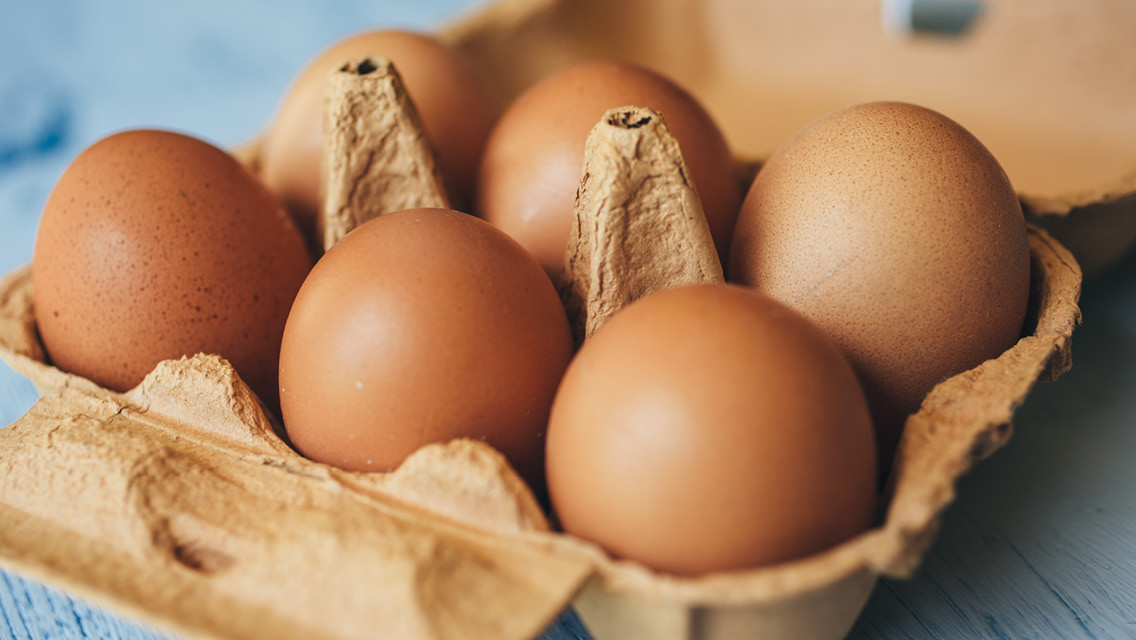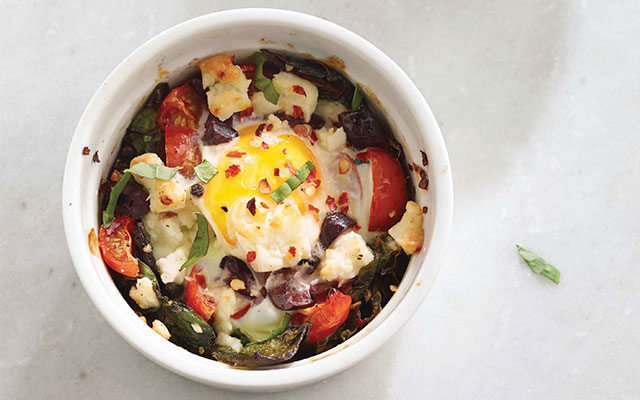Long considered the foe of healthy hearts, eggs are winning back their reputation as one of nature’s most balanced and nutritious foods. These hard-working bundles of vitamins and minerals – which can have a starring role in a meal (think omelets and quiches) or be the essential bit player (the magic ingredient that gives soufflés their fluff) – are indispensable to cooks around the world for their versatility and flavor.
Food Basics
Brown, white, organic, free-range, omega-3 – you’ve got a lot of egg choices. When it comes to getting optimal nutrition and flavor, egg size and color don’t count – but the chickens’ diet and living conditions do.
Seek out eggs from birds raised under healthy and nutrition-minded conditions (not factory farms). You may note stronger shells; brighter, sturdier yolks; and clearer whites. And despite industry insistence to the contrary, you may also enjoy a better nutrient profile and better taste. Some folks prefer organic eggs, others prefer free-range. You can learn the difference and get a sense of the current egg (and meat) controversy in The Omnivore’s Dilemma by Michael Pollan. Chickens fed on flaxseed offer higher levels of omega-3 fatty acids, but you may pay a premium price for the extra nutrition.
Fresh, unbroken eggs can be kept in the carton for up to a month when properly refrigerated. Fresh eggs will sink in a bowl of cold water. If they bob near the surface, dump ’em.
Nutritional Know-How
Eggs got a bad reputation in the mid-20th century when cholesterol was first linked to heart disease. Today, though, the connection between dietary (food) cholesterol and blood (serum) cholesterol is far less certain, and current research suggests that the cholesterol in eggs is unlikely to play a significant role in contributing to heart disease in most people (ask your health professional). As a result, eggs are experiencing a popular resurgence.
Rich in protein, low in sodium, and loaded with essential vitamins and minerals (particularly B vitamins, folic acid and vitamin D), eggs are also high in healthy essential fatty acids. A single large egg contains 75 calories, 5 total grams of fat (1.6 saturated), 6 grams of protein and zero carbs.
Whole eggs provide an excellent balance of amino acids, and they pack the extra punch of lutein and zeaxanthin, two plant-based antioxidants. Keep in mind that the yolks are home to almost all of eggs’ vitamin A and iron, as well as their healthy fats and much of their flavor. Egg white is about 90 percent water and 10 percent protein with some trace minerals and vitamins.
Kitchen Tricks
- Scrambled. In a medium-size bowl, beat eggs (plus a little salt and ground pepper) with a large fork or whisk until well mixed and fluffy. Heat a heavy-bottom pan over medium heat before adding a little olive oil or butter. When the oil begins to bubble, add eggs. Reduce heat to low and begin to stir occasionally as the eggs start to solidify. Eggs cooked slowly will stay moist and fluffy. They continue cooking when removed from heat, so to avoid rubberiness, remove when they are still slightly wet.
- Boiled. Place whole eggs in a pot filled with cold water. Cook eggs over medium-high heat until boiling. As soon as the water comes to a boil, set the timer: For a soft-boiled egg, four to five minutes; medium-boiled, six to seven minutes; hard-boiled, 10 to 12 minutes. When time is up, remove eggs from the hot water and plunge them briefly under cold, running water. Immediately after cooking the eggs, and while they are still slightly warm, gently peel them under cold, running water. (Tip: Dip them briefly in ice water to prevent green yolks.) Place a colander in the sink to catch shell pieces. Hard-boiled eggs can be kept in the shell, refrigerated, for one week.
- Poached. Fill a medium-size pot three-quarters full of cold water. Add 2 tablespoons of white vinegar to the water and bring to a boil. Reduce heat to a low simmer and swirl the vinegar and water with a spoon. Crack open and gently add eggs to the swirling water (one at a time). Cook for three to five minutes for soft- to medium-poached eggs.
Eat Up!
Chefs all over the world prize eggs for their versatility and flavor. They can be baked, boiled and even fermented. And their uses as a key ingredient in other dishes are innumerable. Here are some ideas for making superior eggs as a main dish:
- Get creative when adding veggies and herbs to a scramble. Consider asparagus, sweet peppers, leeks, garlic, spinach, arugula, fresh or dried tomatoes, and wild mushrooms. Fresh basil adds a heady aroma and fresh flavor; crushed tarragon or thyme adds sophistication; curly parsley and ground paprika deliver visual appeal.
- Eggs come alive with the right sauce – think garlic-chili, curry, marinara, even mustard. Want to add some spice but can’t tolerate Tabasco? Try a natural, local or homemade mild salsa, perhaps with a little plain yogurt on the side.
- Serve your salsa and eggs with a tortilla, beans and green chilies for a simple brunch of Huevos Rancheros. Or whip up a vegetable and smoked-trout frittata for a delightful dinner. Try this Arugula and Mushroom Frittata With Chèvre or a Pizza Margherita Frittata.
Miraval Omelet
Makes one omelet
- 1/4 tsp. extra-virgin olive oil
- 1/4 cup diced fresh shiitake mushrooms
- 1 tbs. finely chopped green onion
- 1/4 cup diced fresh tomato
- 1/4 cup packed fresh spinach
- 1 tbs. low-fat cream cheese
- 1 whole egg, plus two egg whites, lightly whipped
- 1/8 tsp. sea salt
- 1/8 tsp. freshly ground black pepper
Directions
- Preheat the broiler.
- Heat a sauté pan with a flameproof handle over medium heat and add the olive oil. Add the vegetables and sauté until they begin to soften, about five minutes.
- Pour the egg whites over the vegetables and season with salt and pepper.
- Cook until the bottom is done and the sides are firm, about four minutes.
- Spread the cream cheese on top of the omelet.
- Place the pan under the broiler for about two minutes to finish cooking the top of the omelet. Remove from heat. Fold over half of the omelet and serve.
Vegetable Quiche With Rice Crust
Serves 8
Crust:
- 2 cups cooked brown rice
- 2 large egg whites
- 1 tbs. finely chopped fresh parsley
- 1 tsp. finely chopped fresh oregano
- 1/4 tsp. sea salt
- 1/8 tsp. freshly ground black pepper
Filling:
- 1/2 tsp. extra-virgin olive oil
- 1/2 cup finely diced red bell pepper
- 1/2 cup finely diced mushroom
- 1/4 cup finely chopped red onion
- 1 cup chopped, packed fresh spinach
- 2 large egg whites
- 2 large eggs
- 3/4 cup fat-free milk
- 1/8 tsp. sea salt
- 1/8 tsp. freshly ground black pepper
- Pinch of nutmeg
- 1/4 cup freshly grated Parmesan cheese
Directions
- Preheat the oven to 350 degrees F.
- For the crust: In a mixing bowl, combine the rice, egg whites, parsley, oregano, salt and pepper. Coat an 8-inch pie pan with cooking spray. Press the rice mixture over the bottom and up the sides of the pie pan to form a crust. Bake for 15 minutes or until the crust is set and lightly browned.
- For the filling: Heat a sauté pan over medium heat and add the olive oil to lightly coat the bottom of the pan. Add the bell pepper, mushroom, onion and spinach; sauté until the onion softens, about five minutes. Remove from heat and set aside.
- To assemble: Place the pie pan with prepared crust on a baking sheet. Spread the vegetables over the bottom of the crust and pour the egg mixture over them.
- Bake for 55 minutes or until the eggs have set. Cut into eight wedges to serve.
Recipes excerpted from Conscious Cuisine by Chef Cary Neff (Sourcebooks, 2002).




This Post Has 0 Comments